January 6, 2002
MONO CLIFFS - 25th Sideroad entrance (North side)
Meeting report by Nathan and Alexis Burnett
Photos by Walter Muma
|
|
|
|
We started the hike at 10 a.m. with a handful of people at the north end
of Mono Cliffs park. Later others joined us, swelling the group to
about 15.
As we walked down the old road into the park
we stopped a number of times to I.D. some of the many species of trees
and shrubs that grow on either side of the road. Black cherry, white
ash, white elm, and trembling aspen were among some of
the trees that we discovered. During winter the trees really seem
to captivate us with their beautiful silhouettes. It can be a
challenging time of year to identify different species, but it also helps
you to look closely at some of the subtle differences between certain
trees.
|
|
|
|

|
We planned to devote a lot of time on this hike to winter
tracking, but with the fresh snow over-night and this morning, there were not too many
visible tracks left on the ground.
As we moved from the road into
the meadow we began to see more signs and "older" tracks and
trails left in the
snow. |
|
| |
|
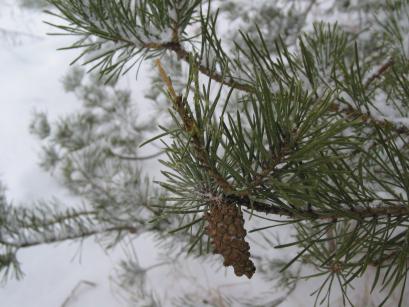
|
We could see how the deer were moving through the field and
what they were feeding on. There were many tracks in the snow
around the apple trees where they had been eating the buds from the
branches.
They were also eating some of the Scots pine needles and
buds as well.
You can see the end of this Scots
pine twig has been chewed off. Also
visible is an unopened Scots pine cone. |
|
| |
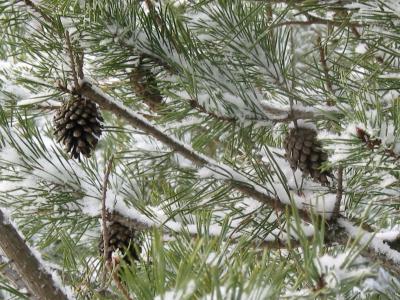 |
From the trails and tracks we could tell that they
like to visit this area frequently, especially at this time of year.
Here is a photo of opened Scots pine cones. |
|
| |
 |
There was a lot of
evidence of porcupines that had chewed the bark off of a number of the
pines. We didn't spot a porcupine here, but we have seen them here
on a few occasions in the past.
This Scots pine has been partially de-barked by a
porcupine.
|
|
| |
| There were some hare tracks
spotted here in the snow, but we couldn't tell if they were snowshoe or
European hare? There was a coating of snow over them, but the
track pattern was still quite visible. There seemed to be some fox
and coyote tracks too, but they were faintly visible besides the oval
compression shapes. |
| |
 |
Walter pointed out to some of us how if you looked at all the trees you
could see that they were slightly bent towards the south-east, showing
that our prevailing winds in this area blow out of the north-west.
This is a good tool to help with aidless navigation (ie, without map or
compass) and finding the
directions. We discussed how some trees are great indicators
and some are more subtle. Some of the better trees for indicating which
way the prevailing winds are blowing seemed to be conifers: spruce
and pine.
Yet if you look closely the
deciduous trees will be good indicators as well.
Note in this picture how the branches are all
turned towards the right. This reflects the prevailing wind which
comes from the left (north/west). |
|
|
|
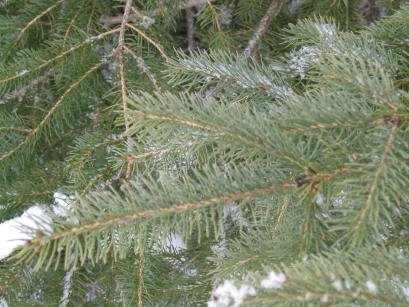 |
We fumbled trying
to I.D. a spruce tree after this. We knew it was a spruce, but
were a bit confused between some of the distinguishing characteristics
between white, black and Norway spruce?
We decided that this certain
tree was a white spruce because of the smell and the needle and bud
formation.
|
|
|
|
|
By this time some of the guys were engaged in a huge
snowball fight and left some of their own tracks in the snow.
There is something that seems irresistible to some when the temperature
rises and the snow begins to "pack" really well. There was
definitely some good times had by all who participated in the "snowball-fight".
You could hear the screams of joy as all animals within 2 miles fled
from us!
|
|
|
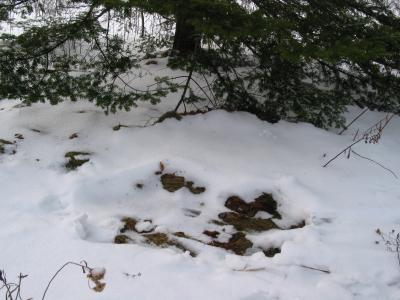 |
Nearby we found a couple of deer lays (places where deer
spend the night) under a balsam fir.
|
|
|
|
|
All along the way we stopped frequently to discuss the
finer points of tree identification, as well as to examine the mosses and
lichens growing on them.
|
|
|
| |
|
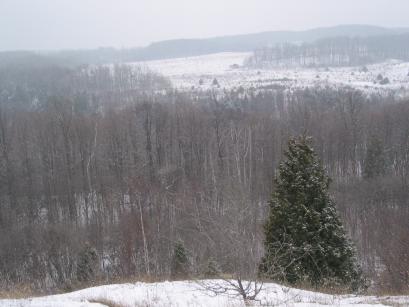
|
We hiked to the northern outlook which looks over the whole park.
What a beautiful spot! A gentle
snow was falling. |
|
| |
|
We stopped here for a while and re-grouped
before heading downhill towards McCarston's lake. As we walked
down the trail we could see where some cottontails had stopped for a nibble
on the Rubus (raspberry & blackberry) canes and spruce needles. There were
some red squirrel tracks here that crossed the trail as well. Good
cedar
habitat here for both mammals.
|
| |
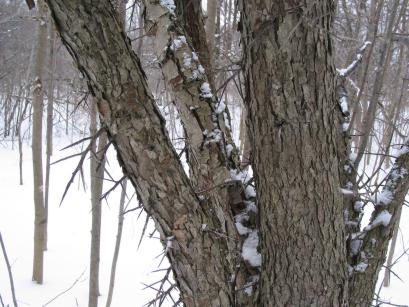 |
As we continued on we noticed all
the spikes on the honey locust trees that could have easily
been mistaken for hawthorns with a brief glance. ADDENDUM:
Oops! Later research and experience showed that it IS a Hawthorn!!
(note added Feb 2004)
|
|
| |
 |
At this point the
forest turned to mostly hardwood trees as we neared the lake.
There are many beautiful gullies and hills in this part of the park.
|
|
| |
|
It felt good as we took in the view of the frozen lake surrounded
by the rolling hills covered in a splendid beech/maple forest.
There were some snow-covered deer tracks moving through the woods here
and we speculated that there were probably some deer in the coniferous
trees off to the west. We decided to "off-trail" back to the cars.
There were quite a few tracks that we found on our way, but they were
snowed in pretty good and it was hard to tell what animal had made them.
There were definitely some deer and what we guessed could have been a fox
or coyote? Some of the freshest tracks of the day were that of a
gray squirrel running full-tilt away from us!
|
| |
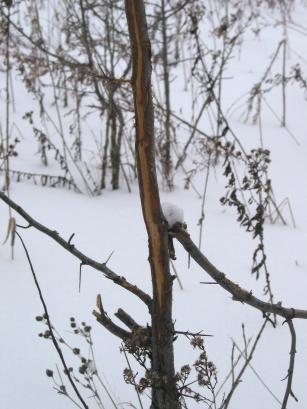 |
As we walked back
through the meadow we noticed some bird nests as well as an antler rub
used by a white-tail deer.
|
|
|
|
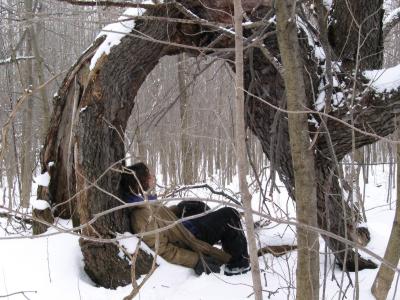 |
We found an unusually bent-over black cherry tree.
|
|
|
|
 |
From here we walked back to the cars
where a surprise had been left for us by one of the groups that had
departed earlier!
|
|
|
|
|
Even though there were not too many fresh tracks
in the snow, we all had a good time being outdoors for the day in such
a beautiful area. Not only did we learn a lot, but it seems like once you are outside it is
quite hard not to have a good time!!!! Thanks to all who came!
|
|
|
|
For more Tree ID information, visit the
Ontario Trees
& Shrubs website |
| |
| |